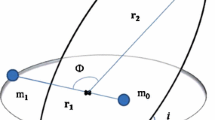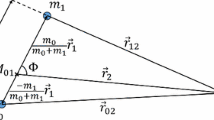Abstract
The stability of hierarchical triple system is studied in the case of an extrasolar planet or a brown dwarf orbiting a pair of main sequence stars. The evolution of triple system is well modelled by random walk (RW) diffusion, particularly in the cases where the third body is small and tracing an orbit with a large eccentricity. A RW model neglects the fact that there are many periodic orbits accompanied by stability islands, and hence inherently overestimates the instability of the system. The present work is motivated by the hope to clarify how far the RW model is applicable. Escape time and the surface section technique are used to analyse the outcome of numerical integrations. The analysis shows that the RW-like model explains escape of the third body if the initial configuration is directly outside of the KAM tori. A small gap exists in (q 2/a 1, e 2)-plane between locations of the stability limit curves based on our numerical study and on RW-model (the former is shifted by –1.4 in q 2/a 1 direction from the latter).
Similar content being viewed by others
References
Chauvin G., Beust H., Lagrange A.-M., Eggenberger A.: Planetary systems in close binary stars: the case of HD 196885. Combined astrometric and radial velocity study. Astron. Astrophys. 528, 8 (2011)
Chirikov B.V.: A universal instability of many-dimensional oscillator systems. Phys. Rep. 52(5), 263–379 (1979)
Froeschlé C., Lega E., Gonczi R.: Fast Lyapunov indicators. Application to asteroidal motion. Celst. Mech. Dyn. Astron. 67, 41–62 (1997)
Georgakarakos N.: Stability criteria for hierarchical triple systems. Celest. Mech. Dyn. Astron. 100, 151– 168 (2008)
Gladman B.: Dynamics of systems two close planets. Icarus 106, 247–263 (1993)
Golubev V.G.: Regions where motion is impossible in the three body problem. Doklady. Akad. Nauk. SSSR 174, 767–770 (1967)
Hadjidemetriou J.D.: Celest. Mech. Dyn. Astron 95, 225–244 (2006)
Hairer, E., Norsett, S.P., Wanner, G.: Solving ordinary differential equations I: Nonstiff problems. Springer Series in Computational Mathematics, Chapter II.9 (1993)
Harrington R.S.: Stability criteria for triple stars. Celest. Mech. 6, 322–327 (1972)
Harrington R.S.: Planetary orbits in binary stars. Astron. J. 82, 753–756 (1977)
Higuchi T., Kitagawa G.: Knowledge discovery and self-organizing state space model. IEICE Trans. Inf. Syst. E83-D(1), 36–43 (2000)
Holman M.J., Wiegert P.A.: Long-term stability of planets in binary systems. Astron. J. 117, 621–628 (1999)
Kitagawa G., Gersch W.: Smoothness Priors Analysis of Time Series. Springer, New York (1996)
Kitagawa G., Sato S.: Monte Carlo smoothing and self-organaising state-space model. In: Doucet, A., de Freitas, N., Gordon, N. (eds) Sequential Monte Carlo Methods in Practice, pp. 177–195. Springer, New York (2001)
Lichtenberg A.J., Lieberman M.A.: Regular and Chaotic Dynamics. Springer, Berlin (1992)
Lecar M., Franklin F., Murison M.: On predicting long-term orbital instability: a relation between the Lyapunov time and sudden orbital transitions. Astron. J. 104(3), 1230–1236 (1992)
Marchal C., Saari D.G.: Hill regions for the general three-body problem. Celest. Mech. 12, 115–129 (1975)
Marchal C., Bozis G.: Hill stability and distance curves for the general three-body problem. Celest. Mech. 26, 311–333 (1982)
Mardling R.A., Aarseth S.J.: Dynamics and stability of three-body systems. In: Steves, B.A., Roy, A.E. (eds) The Dynamics of Small Bodies in the Solar System, A Major Key to Solar System Studies. NATO ASI, vol. 90, pp. 385–392. Kluwer, Dordrecht (1999)
Mikkola S., Tanikawa K.: Correlation of macroscopic instability and Lyapunov times in the general three-body problem. Mon. Not. R. Astron. Soc. 379, L21–L24 (2007)
Mudryk L.R., Wu Y.: Resonance overlap is responsible for ejecting planets in binary systems. Astrophys. J. 639, 423–431 (2006)
Orlov V.V., Rubinov A.V., Valtonen M., Mylläri A., Zhuchkov R.: Stability of triple systems. In: Orlov, V.V., Rubinov, A.V. (eds) Resonances, Stabilization, and Stable Chaos in Hierarchical Triple Systems, St. Petersburg State University, St. Petersburg (2008)
Orlov V.V., Rubinov A.V., Shevchenko I.I.: The disruption of three-body gravitational systems: lifetime statistics. Mon. Not. R. Astron. Soc. 408, 1623–1627 (2010)
Pilat-Lohinger E., Funk B., Dvorak R.: Stability limits in double stars. Astron. Astrophys. 400, 1085–1094 (2003)
Shevchenko I.I.: Hamiltonian intermittency and Lévy flights in the three-body problem. Phys. Rev. 81, 066216-1–066216-11 (2010)
Stiefel E.L., Scheifele G.: Linear and Regular Celestial Mechanics. Springer, New York (1971)
Szenkovits F., Mako Z.: About the Hill stability of extrasolar planets in stellar binary systems. Celest. Mech. Dyn. Astron. 101, 273–287 (2008)
Tanikawa, K., Mikkola, S.: 2008 A trial symbolic dynamics of the planar three-body problem. In: Orlov, V.V., Rubinov, A.V. (eds.) Proceedings of Resonances, Stabilization, and Stable Chaos in Hierarchical Triple Systems. St. Petersburg State Univ., St. Petersburg, 26–29 August (2007)
Thébault P.: Against all odds? Forming the planet of the HD 196885 binary. Celest. Mech. Dyn. Astron. 111, 29–49 (2011)
Valtonen M., Karttunen H.: The Three-Body Problem. Cambridge University Press, Cambridge (2006)
Valtonen, M., Mylläri, A., Orlov, V.V., Rubinov, A.V.: Dynamical evolution of dense stellar systems. In: Vesperini, E., Giersz, M., Sills, A. (eds.) Dynamical Evolution of Dense Stellar Systems, Capri, Italy, 5–9 September 2007. Proceedings of the International Astronomical Union. IAU Symposium, vol. 246, pp. 209–217. Cambridge University Press, Cambridge (2008)
Wisdom J.: The resonance overlap criterion and the onset of stochastic behavior in the restricted three-body problem. Astron. J. 85(8), 1122–1133 (1980)
Yoshida J.: Improved criteria for hyperbolic-elliptic motion in the general three-body problem II. Publ. Astron. Soc. Jpn. 26, 367–377 (1974)
Zare K.: The effects of integrals on the totality of solutions of dynamical systems. Celest. Mech. 14, 73–83 (1976)
Zare K.: Bifurcation points in the planar problem of three bodies. Celest. Mech. 16, 35–38 (1977)
Zhou J.L., Sun Y.S., Zheng J.Q., Valtonen M.J.: The transfer of comets from near-parabolic to short-period orbits: map approach. Astron. Astrophys. 364, 887–893 (2000)
Zhou J.L., Sun Y.S., Zhou L.Y.: Evidence for Lévy random walks in the evolution of comets from the Oort Cloud. Celest. Mech. Dyn. Astron. 84, 409–427 (2002)
Author information
Authors and Affiliations
Corresponding author
Rights and permissions
About this article
Cite this article
Saito, M.M., Tanikawa, K. & Orlov, V.V. Disintegration process of hierarchical triple systems. I. Small-mass planet orbiting equal-mass binary. Celest Mech Dyn Astr 112, 235–251 (2012). https://doi.org/10.1007/s10569-011-9395-6
Received:
Revised:
Accepted:
Published:
Issue Date:
DOI: https://doi.org/10.1007/s10569-011-9395-6




